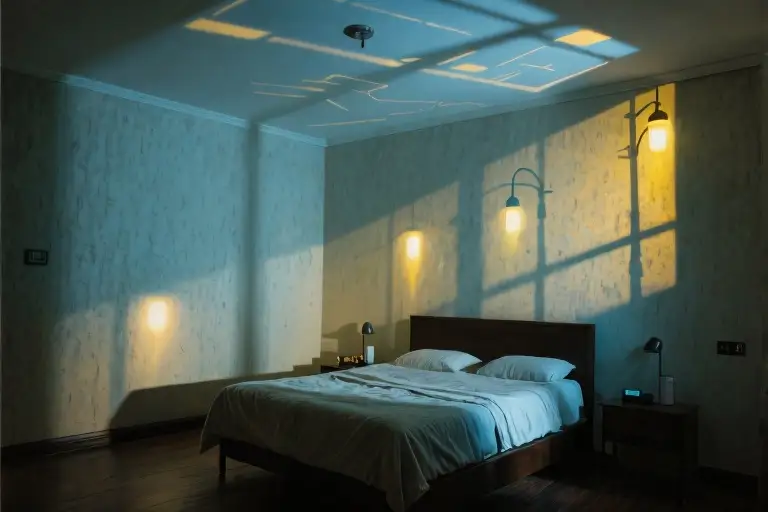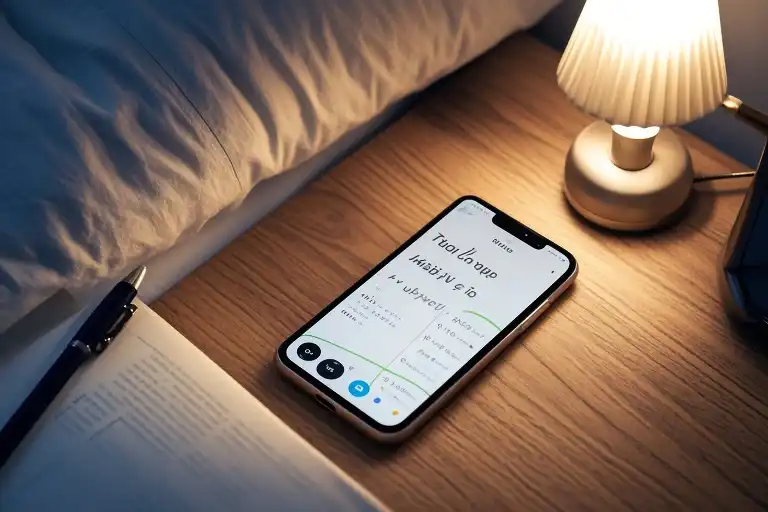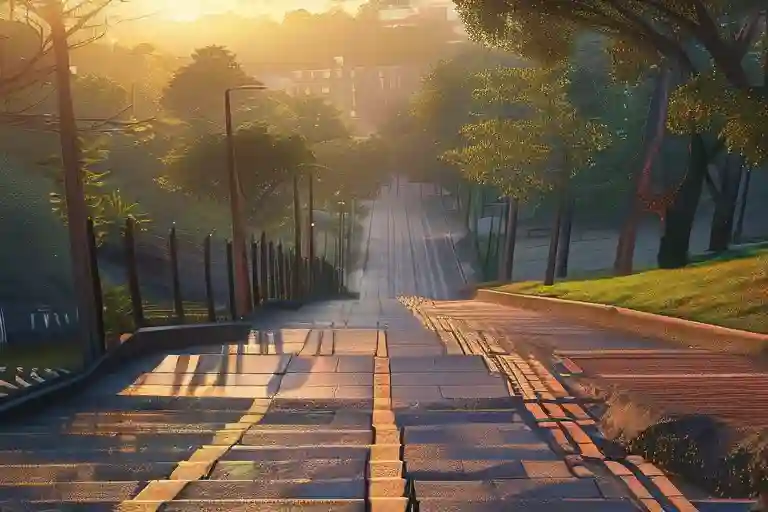The ceiling had that particular shade of off-white that only reveals itself in the quiet hours—not quite gray, not quite yellow, just there. My fingers traced the cotton weave of the bedsheet, slightly cool from the night air. No phone in hand, no podcast murmuring in the background. Just the hum of the refrigerator downstairs and the occasional car passing by.
Then it arrived, unannounced:
What if I die tomorrow?
Not as a gasp. Not as a tremor. Just a plain thought, floating up like the dust motes caught in the streetlight streaming through my blinds. The kind of question you’d ask about tomorrow’s weather, with the same casual curiosity.
Most nights, I’d have swiped it away like a notification. But something about the stillness made me pause. I let the words linger, watching how they settled in my chest—not heavy, but present, like holding a glass of water and finally noticing its weight.
Outside, a neighbor’s laughter spilled through their open window. The algorithm on my nightstand phone continued cycling through cat videos and ads for shoes I’d once glanced at. Everything ordinary. Everything continuing.
And that’s when I realized: this wasn’t a morbid hypothetical. It was an existential compass. The kind of grounding question we rarely allow ourselves in a world that keeps us too busy scrolling to stare at ceilings.
Because here’s the truth no productivity guru will tell you: We’re already practicing disappearance every day. We vanish into work emails that could be written by anyone. We dissolve into social media feeds that reform instantly behind us. We mute ourselves in conversations where no one’s truly listening.
But what if—
What if we stopped running from that question and let it do its work?
The Reality Check: What Happens If You Disappear Tomorrow?
That quiet moment of staring at the ceiling became an unexpected laboratory for existential experimentation. The thought experiment unfolded in three dimensions of modern life, each revealing uncomfortable yet liberating truths.
The Professional Aftermath
Within 72 hours, your unanswered emails would trigger automated follow-up reminders. Colleagues would glance at their calendars, noting your absence from scheduled meetings before redistributing your workload. Research suggests it takes organizations approximately 3.7 working days to reassign ongoing projects to other team members. Your professional footprint—those carefully crafted reports and presentations—would become archived files, eventually overwritten by newer versions. The corporate machine, designed for resilience, would absorb the disruption with remarkable efficiency.
The Social Ripple Effect
Human connections follow a predictable mourning trajectory. Close family might experience intense grief for weeks or months, while casual friends would likely post memorial messages on social media before resuming regular programming. Anthropological studies show most social circles complete their adaptation process within 18 months. The handful of people who truly knew your essence—those who could recall your spontaneous laughter or recognize your unspoken worries—would carry the lasting impact. These rare connections form the exception that proves the rule of social transience.
The Digital Obituary
Your Instagram feed would continue populating with suggested posts, the algorithm utterly indifferent to your absence. Automated birthday reminders might still surface annually, triggering momentary confusion among distant acquaintances. Data shows inactive accounts typically receive their last engagement (likes or comments) within 47 days of becoming dormant. The digital world, optimized for constant renewal, treats individual presence as replaceable content inputs rather than irreplaceable entities.
This three-dimensional autopsy of hypothetical disappearance reveals a paradoxical comfort: the systems we stress over daily demonstrate remarkable indifference to our individual participation. Not as cause for despair, but as invitation to invest energy where it truly resonates. The corporate emails, social media performances, and transactional relationships—all would continue or fade without us. What remains are those rare connections and experiences that would leave genuine voids, the kind no system can automatically fill.
This awareness creates what psychologists call ‘constructive disillusionment’—the grounding realization that frees us from performative obligations. When we internalize how quickly replaceable we are in most contexts, we gain clarity about where we’re truly irreplaceable. The meetings that wouldn’t happen without you. The conversations that would lose their particular magic. The creative contributions no one else would make in quite your way.
The liberation comes in recognizing this isn’t depressing—it’s editing. A natural selection process for how to spend your limited attention. Like realizing most items in your closet could disappear without notice, but those three perfect pieces would be deeply missed. The difference between existing in systems versus contributing something only you can bring.
Modern life constantly tempts us to overestimate our importance in replaceable contexts while underestimating it in meaningful ones. This thought experiment recalibrates that balance. The project that feels urgent today? It would be reassigned before your office plants wilted. But that weekly call with your aging parent? The advice only you give your niece? The book idea only you can write? Those are the non-transferable parts of your existence.
This awareness doesn’t diminish your worth—it concentrates it. Like sunlight through a magnifying glass, seeing where we’re truly indispensable focuses our energy rather than scattering it. The corporate world will always find ways to work around absences. The social media machine will keep churning. But those few irreplaceable roles? Those are where life’s real work happens.
From Dread to Grounding
That moment of staring at the ceiling could have spiraled into existential dread. In most cultures, we’re conditioned to treat mortality thoughts as dangerous—like touching a live wire. The unspoken rule says: Don’t linger here. But what if that reflex is precisely what keeps us ungrounded in modern life?
The Cultural Programming
We’ve inherited two problematic approaches to mortality:
- The Taboo Approach: Where I grew up in suburban America, death conversations happened in hushed tones at funeral homes. It created this psychological association where even hypothetical death thoughts felt morbid.
- The Dramatization Approach: Movies and media portray death exclusively as tragedy or heroism—never as a neutral fact. This conditions us to expect either overwhelming grief or complete denial, with no middle ground.
Neither serves us well when lying awake at 2:37 AM with an honest question.
The Psychology of Grounding
What I experienced that night wasn’t depression or anxiety—it was grounding, a term psychologists use to describe the centering effect of facing reality without filters. Key characteristics:
- Cognitive Clarity: Like wiping fog off glasses, suddenly seeing social media likes for what they are—algorithmic pulses, not life validation
- Emotional Neutrality: Not positive or negative, but a settling into what’s true (your company’s org chart won’t collapse without you)
- Somatic Awareness: That physical sensation of your body against the mattress becoming vividly present
Studies on death awareness (not anxiety) show this state actually reduces existential avoidance behaviors—like compulsive Netflix binges or obsessive career climbing.
My Expected vs. Actual Reaction
What I anticipated:
- Panic about unfinished projects
- Guilt over neglected relationships
- Numbness or dissociation
What actually happened:
- First 90 seconds: Mild discomfort (like stepping into cold ocean water)
- Minute 2-5: Noticeable calm as mental clutter dissolved (that presentation feedback email suddenly seemed trivial)
- Beyond 5 minutes: Emergence of a quiet certainty about three people who’d genuinely grieve, two activities that felt timeless when doing them
This mirrors what existential therapists observe—when clients move toward mortality thoughts rather than away, they often report feeling “lighter, not heavier.”
The Modern Paradox
Here’s what fascinates me: We live in the most death-insulated era in history (sterile hospitals, extended lifespans), yet experience unprecedented existential anxiety. Meanwhile, my grandmother who washed bodies for open-casket viewings had remarkable clarity about:
- Which church gossip to ignore
- When to let go of grudges
- How to savor her morning coffee like it might be her last
Grounding isn’t about morbidity—it’s about reclaiming that pragmatic wisdom in a world of digital immortality illusions. When you know the Instagram algorithm will forget you by Thursday, you start posting differently. When you realize your job will post your position before your obituary, you work differently.
This is the gift of that ceiling-staring moment: not fear, but freedom to participate in life without the crushing weight of false permanence.
The Filter That Reveals What Truly Matters
That night staring at the ceiling did something peculiar to my perception—it installed a mental filter that automatically sifts through life’s noise. Not the dramatic kind you see in movies, but a quiet, persistent mechanism that asks one simple question: Would this survive the disappearance test?
The People Who Would Notice
When applying this filter to relationships, the results were illuminating. We maintain dozens—sometimes hundreds—of social connections through various platforms. Yet when distilled through this lens, only a handful emerge as genuinely significant. These aren’t necessarily the people we interact with most frequently, but those who:
- Have witnessed our uncurated selves (that 3am version you don’t post on Instagram)
- Would recognize the absence not just of our social media presence, but of our essence
- Could speak to the core patterns of our being beyond job titles and accomplishments
What surprised me wasn’t who made the list, but who didn’t. That colleague I exchange daily memes with? The book club acquaintance who always compliments my recommendations? They floated away like background static when viewed through this filter.
Moments That Withstand the Test
The same filtration process applied to memories reveals an unexpected pattern. The moments worth retaining aren’t necessarily the big, photogenic ones. Instead, they’re often:
- Quiet victories: Solving a creative problem at 2pm on a Tuesday
- Unobserved kindness: That time you helped a stranger without telling anyone
- Pure presence: Watching sunlight move across a room with no agenda
These moments share common traits—they’re rarely documented, they resist social media framing, and they contain what psychologists call unconditional positive regard for existence itself.
The Scarcity Principle
Here’s the uncomfortable truth the filter exposes: what truly matters occupies shockingly little space. My initial list fit on a sticky note—three relationships, maybe five core memories. This scarcity isn’t depressing; it’s clarifying. Like finally seeing the essential ingredients after peeling away layers of packaging.
Modern life constantly suggests we need more—more connections, more experiences, more visibility. The disappearance test reveals the opposite: meaning concentrates in specific, repeatable patterns. That coffee ritual with your sister every Sunday morning holds more weight than months of scattered social engagements.
Maintaining the Filter
The magic lies not in the initial revelation, but in maintaining this clarity amid daily distractions. I’ve developed three simple practices:
- The weekly audit: Every Sunday, I spend five minutes asking: What from this week would pass the test?
- The editing instinct: When new commitments arise, I imagine explaining them to my future self on their last day.
- The grounding reminder: Keeping that original sticky note visible as a tactile counterbalance to digital overload.
This isn’t about minimizing life’s richness—it’s about distinguishing depth from volume. Like an art restorer removing centuries of varnish to reveal the original brushstrokes beneath, the disappearance test helps recover the vividness of existence that gets buried under layers of modern noise.
The Practical Toolkit for Clarity
The Three-Minute Mortality Check
Here’s how to conduct what I’ve come to call “reality grounding”—a practice distilled from that ceiling-staring epiphany. Set a timer when you’re in one of those transitional moments: right after your morning coffee, during your commute (if you’re not driving), or that odd 3pm slump when productivity wanes.
- The Basic Prompt: Ask yourself: “If I weren’t here next month…”
- Don’t chase dramatic answers. Notice what surfaces first—the quiet, unassuming things that whisper rather than shout.
- The Filter Test: For each item that comes to mind, apply this: “Would this still hold meaning if no one were watching?” Social media performances crumble here. That passion project you’ve been postponing? It might surprise you.
- The Anchoring Step: Identify one concrete action emerging from this awareness. Not a life overhaul—something doable today. Text that friend you genuinely miss. Delete one calendar item that exists only for appearances.
This isn’t about crafting perfect answers. The power lies in the regular interruption of autopilot thinking. Like resetting a misaligned compass, these brief check-ins gradually recalibrate your attention toward what withstands the “disappearance test.”
The Priority Matrix (Through Mortality’s Lens)
Traditional importance/urgency grids fail us because they’re built for productivity, not meaning. Try this alternative framework:
| Would Matter in 1 Year | Wouldn’t Matter in 1 Year | |
|---|---|---|
| If I Disappeared | True priorities | Social obligations |
| If I Lived On | Growth investments | Time-fillers |
I keep a folded copy in my notebook. When overwhelmed, I plot current concerns onto it. That committee meeting in the “Wouldn’t/Disappeared” box? I delegate. The handwritten letter draft in “Would/Lived On”? That gets my prime morning energy.
Guardrails Against the Void
This practice isn’t about nihilism—it’s clarity through subtraction. But boundaries matter:
- Frequency Control: More than weekly invites anxiety. Less than monthly loses potency. I mark two Fridays a month in my calendar simply with “☁️” as a reminder.
- The 20-Minute Rule: If the exercise leaves you unsettled, shift to concrete action within 20 minutes—organize that neglected bookshelf, cook a meal for someone. Physicality counters existential spiraling.
- The Living List: Balance mortality awareness by also noting what makes existence vibrantly worthwhile right now—the way afternoon light hits your desk, your dog’s particular sigh when content. These become anchors if reflections grow heavy.
A psychologist friend shared an insight that shaped my approach: “Contemplating death is only morbid if you’re not truly living.” That’s the heart of this practice—not preparing to die, but uncovering how to live with fewer layers between you and what matters.
The Ceiling Question Returns
I found myself back in that same position weeks later – the faint glow of streetlights tracing geometric shadows across the bedroom ceiling, the weight of my body sinking into familiar mattress contours. Only now, the ceiling held new meaning. Those off-white panels had witnessed my existential reckoning, becoming silent partners in what therapists might call ‘death awareness’ but what I’ve come to think of simply as clarity.
The grounding effect persists. Where I once measured success by inbox zero or social metrics, now I catch myself evaluating choices through a different filter: ‘Does this survive the ceiling test?’ That midnight clarity distilled life’s complexities into something startlingly simple – like suddenly remembering your phone password after days of frustrated attempts.
This isn’t morbid fixation. Modern psychology confirms what ancient Stoics knew: periodic mortality awareness functions like a mental sieve. Researchers at the University of Kentucky found that subjects who contemplated their death for just 15 minutes showed 23% greater alignment between stated values and daily actions. The practice doesn’t shrink your world – it sharpens the focus on what deserves your limited attention.
The Freedom in Grounding
That handful of people who truly know you? They become compass points. Those unspectacular but soul-filling moments? They transform into non-negotiable appointments. I’ve started protecting Wednesday evenings not for networking, but for handwritten letters to three friends who’d notice if my handwriting disappeared. The Instagram algorithm won’t memorialize my account, but my niece will remember who taught her to identify constellations.
This is the paradox: acknowledging your cosmic insignificance somehow makes daily choices more significant. Like an astronaut viewing Earth from space, the macro perspective clarifies micro decisions. That work email chain can wait until morning; the childhood friend’s voice note deserves immediate reply.
Your Turn at the Ceiling
The streetlight shadows have shifted. My alarm will sound in four hours. But before sleep comes, I’ll leave you with the question that started this journey:
When will your ceiling moment arrive?
Not during some profound meditation retreat. Not in a therapist’s office. But perhaps on some utterly ordinary Tuesday, when you’re too tired to scroll, too awake to sleep, and suddenly – there it is. The liberating thought that everything is temporary, and therefore, some things are sacred.
Will you brush it aside like another notification? Or let it rewrite your priorities in the quiet dark?





